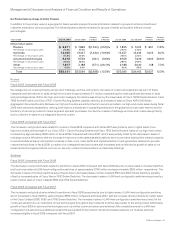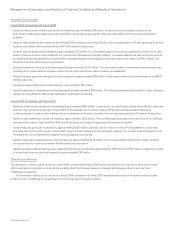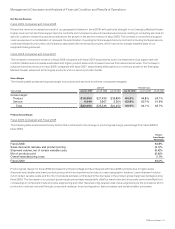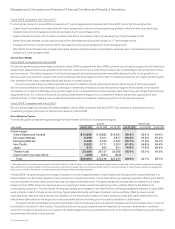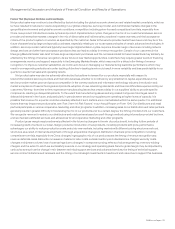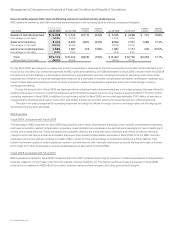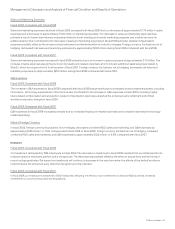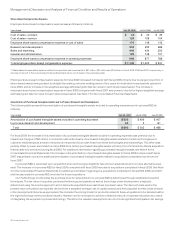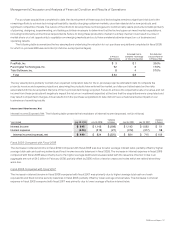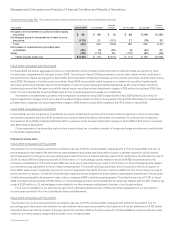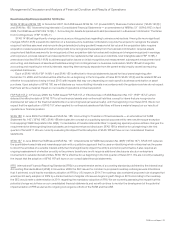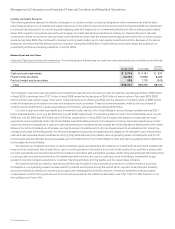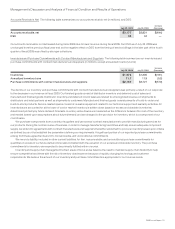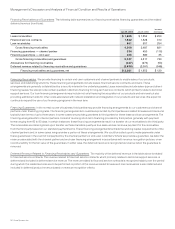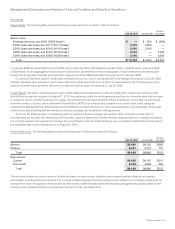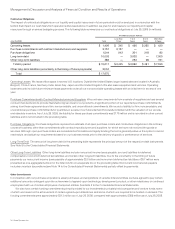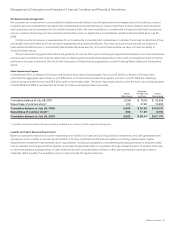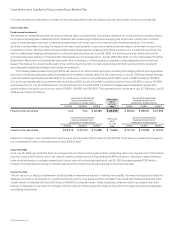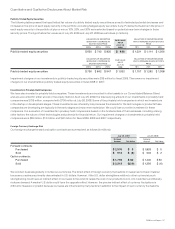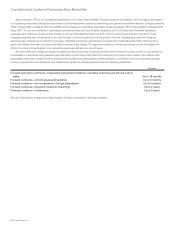Cisco 2009 Annual Report Download - page 31
Download and view the complete annual report
Please find page 31 of the 2009 Cisco annual report below. You can navigate through the pages in the report by either clicking on the pages listed below, or by using the keyword search tool below to find specific information within the annual report.
Management’s Discussion and Analysis of Financial Condition and Results of Operations
Recent Accounting Pronouncements Not Yet Effective
SFAS 141(R) and SFAS 160 In December 2007, the FASB issued SFAS No. 141 (revised 2007), “Business Combinations” (“SFAS 141(R)”)
and SFAS No. 160, “Noncontrolling Interests in Consolidated Financial Statements — an amendment of ARB No. 51” (“SFAS 160”). In April
2009, the FASB issued FSP FAS 141(R)-1, “Accounting for Assets Acquired and Liabilities Assumed in a Business Combination That Arise
from Contingencies” (“FSP 141(R)-1”).
SFAS 141(R) will significantly change previous accounting practices regarding business combinations. Among the more significant
changes, SFAS 141(R) expands the definition of a business and a business combination; requires the acquirer to recognize the assets
acquired, liabilities assumed and noncontrolling interests (including goodwill) measured at fair value at the acquisition date; requires
acquisition-related expenses and restructuring costs to be recognized separately from the business combination; requires assets
acquired and liabilities assumed to be recognized at their acquisition-date fair values with subsequent changes recognized in earnings;
and requires in-process research and development to be capitalized at fair value as an indefinite-lived intangible asset. FSP 141(R)-1
amends and clarifies SFAS 141(R) to address application issues on initial recognition and measurement, subsequent measurement and
accounting, and disclosure of assets and liabilities arising from contingencies in a business combination. SFAS 160 will change the
accounting and reporting for minority interests, reporting them as equity separate from the parent entity’s equity, as well as requiring
expanded disclosures.
Each of SFAS 141(R), FSP 141(R)-1 and SFAS 160 is effective for financial statements issued for fiscal years beginning after
December 15, 2008, and therefore will be effective for us beginning in the first quarter of fiscal 2010. SFAS 141(R) and its related FSP are
effective for acquisitions closing in fiscal 2010, with impacts that may vary depending on each specific business combination or asset
purchase. Upon adoption of SFAS 160, we will disclose our noncontrolling interests in accordance with the guidance and we do not expect
that there will be a material impact on our results of operations or financial position.
FSP FAS 157-2 In February 2008, the FASB issued FSP FAS 157-2, “Effective Date of FASB Statement No. 157” (“FSP 157-2”), which
delayed the effective date of SFAS 157 for all nonfinancial assets and nonfinancial liabilities, except for items that are recognized or
disclosed at fair value in the financial statements on a recurring basis (at least annually), until the beginning of our fiscal 2010. We do not
expect that the application of SFAS 157, when applied to nonfinancial assets and liabilities, will have a material impact on our results of
operations or financial position.
SFAS 166 In June 2009, the FASB issued SFAS No. 166, “Accounting for Transfers of Financial Assets — an amendment of FASB
Statement No. 140” (“SFAS 166”). SFAS 166 eliminates the concept of a qualifying special-purpose entity; removes the scope exception
from applying FASB Interpretation No. 46(R), “Consolidation of Variable Interest Entities” to qualifying special-purpose entities; changes the
requirements for derecognizing financial assets; and requires enhanced disclosure. SFAS 166 is effective for us beginning in the first
quarter of fiscal 2011. We are currently evaluating the impact that the adoption of SFAS 166 will have on our consolidated financial
statements.
SFAS 167 In June 2009, the FASB issued SFAS No. 167, “Amendments to FASB Interpretation No. 46(R)” (“SFAS 167”). SFAS 167 replaces
the quantitative-based risks and rewards approach with a qualitative approach that focuses on identifying which enterprise has the power
to direct the activities of a variable interest entity that most significantly impact the entity’s economic performance. It also requires an
ongoing reassessment of whether an entity is the primary beneficiary, and it requires additional disclosures about an enterprise’s
involvement in variable interest entities. SFAS 167 is effective for us beginning in the first quarter of fiscal 2011. We are currently evaluating
the impact that the adoption of SFAS 167 will have on our consolidated financial statements.
IFRS International Financial Reporting Standards (IFRS) is a comprehensive series of accounting standards published by the International
Accounting Standards Board (IASB). In November 2008, the SEC issued for comment a proposed roadmap outlining several milestones
that, if achieved, could lead to mandatory adoption of IFRS by U.S. issuers in 2014. The roadmap also contained proposed rule changes that
would permit early adoption of IFRS by a limited number of eligible U.S. issuers beginning with filings in 2010. According to the roadmap,
the SEC would make a determination in 2011 regarding the mandatory adoption of IFRS. We are currently assessing the impact that this
potential change would have on our consolidated financial statements, and we will continue to monitor the development of the potential
implementation of IFRS as well as the ongoing convergence efforts of the FASB and the IASB.
2009 Annual Report 29


